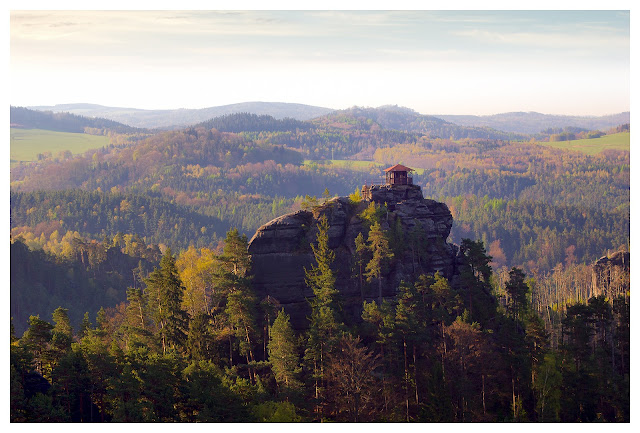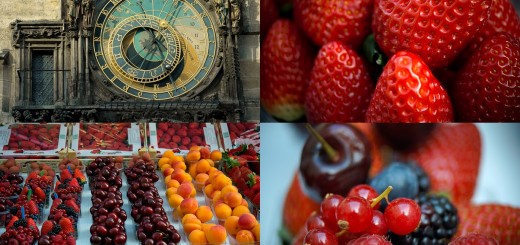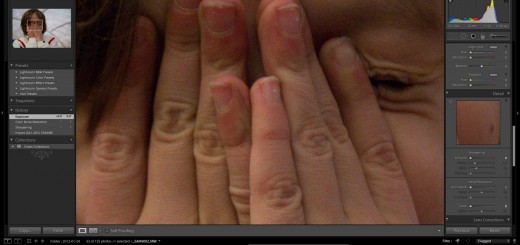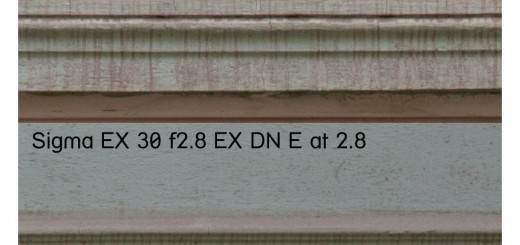Sony NEX and Landscape
 |
| Sony NEX 5n + Carl Zeiss Tevidon 35 f1.9at f8 |
Last weekend I packed Sony NEX 5n and 7 for the 3 days photo trip to Ceske Svycarsko, area known by sandstone rocks and green hills.
Most of interesting view points requires around 60 min. of climbing rather steep hills and stair paths.
Sunrise was at 5:30 a.m, so I needed to be on location around 5a.m.
It is a challenge for many occasional landscape photographers, especially the one who is writing those lines.
 |
| Sony NEX 7 + Leica 35-70 f4 at 35mm and f16 |
That’s why I wanted to try NEX, as every gram counts.
Selection of cameras was easy, but I spent quite some time considering which lenses to pack. My first advice therefore will be – don’t buy more lenses than you need and will use, otherwise you might end up as me – spending more time on packing then shooting, always forgetting something important and always regretting my choice, once I get on location.
Seriously, many great landscape photographers that I know are using Canon EF 17-40 f4 and 70-200 f4 and that’s it. No fancy primes, super wides or tilt/shifts. You are usually shooting at f11-f22 and most lenses in that f-stops performs well, even for the big prints. Not to mention that large number of us rarely print above A3+.
On contrary I have probably more lenses than printed photos, so I had really hard time to make up my mind.
 |
| Sony NEX 7 + Sigma 19mm f2.8 EX DN E at f11 |
Here is what I finally packed:
Sony NEX 5n + EVF, NEX 7, Carl Zeiss Tevidon 35 f1.9, Zeiss Distagon EF 21 f2.8 ZE (EF mount), Samyang 14 f2.8 (EF mount), Conurus/Metabones Smart adapter for EF to NEX, Leica R 35-70 f4, Leica R 80-200 f4, Kipon Leca-R to NEX adapter and Sigma 19mm f2.8 EX DN E.
Other equipment in my backpack were – charger with 4 extra batteries, set of LEE filters (soft, hard graduals, ND and some color graduals and appropriate adapter ring for Zeiss 21 (82 mm thread) and Leica lenses (60mm thread), 1 slim Kenko circular polarizer for Zeiss 21.
Head lamp Led Lenser H7R for night walks in the forest, Led Lenser P14 if I get the chance to try some painting with light, Leatherman (for the bears if they shows up 🙂 and beer bottles that always shows up), air blower, Rodenstock micro fiber, Kinetics lens cleaner solution, lens pen and nylon rain cover for bigger DSLR cameras.
Gitzo GT1541T tripod with a Sirui K10-X ball head, Novoflex universal L bracket, infrared remote for NEX, 4 SD cards, some gaffer tape, and black wrap.
Put two 0.5 l bottles of water and couple of snacks, and all above mentioned in the Lowepro DryZone 100, I still was the guy with the biggest… backpack, despite the fact that my other friends all carried their DSLR systems.
First problem…
I counted on Zeiss 21mm f2.8 (EF mount) to be my main lens in combination with NEX 7 and Conorus/Metabones Smart EF to NEX adapter.
 |
| Sony NEX 7 + Leica 35-70 f4 at 40mm and f8 |
Well, I should have tried it before, but adapter did come a day before the trip, and Metabones are listing the lens to be compatible with the adapter on their pages.
Well it is compatible in terms of aperture adjustment but it doesn’t allow focus to infinity.
Finito. Plan A was just blown away and I had to put Leica 35-70, for which I bought quite rare 60mm to 62mm reduction ring, as I had LEE ring of 62mm. Same diameter – 60mm is also on my Leica 80-200 f4, so I was happy not to carry full bag of rings and adapters.
But… I could left at home all my filters and ring adapters, as Leica 35-70 can’t focus to infinity when ring adapter is mounted. Front element collides with the ring. Leica 80-200f4 has built in hood, so I couldn’t even mount filter ring.
Last three lenses in my bag were Samyang with bulb front element, Tevidon with atypical small thread and Samsung with a 46mm filter thread that I don’t have ring for.
Samyang 14 f 2.8 seems to focus to infinity with Metabones adapter, but just so, so… I am not 100% sure and will have to double-check it, but at f11 images from Samyang seems to be sharp across the frame, so I guess it’s OK.
 |
| Sony NEX 7 + Sigma 19mm f2.8 EX DN E at f8 |
Second problem…
Having no filters, I needed to bracket shots to preserve the possibility of combining the exposures later.
There are two problems with it…
a) Bracketing function is limited to -0.7 to +0.7, and only 3 shots, which is very small range. This is well known, and I rather did use manual exposure correction instead automatic exposure bracketing.
b) what I didn’t think about is, that when using auto bracketing, you can’t use any sort of remote triggering or at least 2-10s trigger delay.
That means, that for any sort of bracketing – auto or manual, you need to touch your camera. This is a big flaw in my eyes for NEX as a landscape tool, where bracketing is used very often, not only for the HDR purposes.
 |
| Sony NEX 7 + Leica Vario Elmar R 80-200mm f4 at 200mm and f11 |
Third problem…
Camera base for tripod mounting plate is very tiny. That cause my arca-swiss standard plates to easily screw off, whenever I tried to adjust ball head by holding the camera. For the NEX you should really try in store mounting plates as many might be fiddly when fixed.
Combination of those three problems, meant that I had to change my usual work-flow. I needed to take in a count not only composition and light, but also overall stability, and re-checking focus after every bracketed shot. I also had to wait for the wind to calm down, because I didn’t fully trusted my camera – tripod connection. Lack of possibility to use my filters, made me feel as an tourist, rather than photographer.
 |
| Sony NEX 7 + Leica 35-70 f4 at 35mm and f11 |
But there are of course many positives. Weight and size was already mentioned and flipping LCD is another nice benefit. Usually, I don’t shot over sunny day, except some macro in the forest. Therefore I was able always to see well image on LCD, magnify it and using also peaking, get the proper focus.
 |
| Sony NEX 5n + Carl Zeiss Tevidon 35 f1.9at f11 |
Using my DSLR, I am always using manual focusing anyway, unless I shot some faster movement, and achieving proper MF on NEX is simply easier and more pleasant experience.
I am strictly RAW shooter, and in general I even don’t read that part of the instruction manual where all those jpeg functions and modes are offered. Things like twilight mode, anti blur mode, all those scene presets etc. Whenever I opened such an image in the editor and look at the pixel size, I just close it immediately and throw to the basket.
Problem however is not in an image, but in a habit to pixel peep it.
That leads me to the NEX 5n and 7 function – sweep panorama. As I had more time on a location, that I would normally spent in selecting and adjusting filters, I tried that panorama stuff.
Don’t expect miracles. If you like to look at image at 100% on your monitor, this function is not for you. But it is a great fun to use it. It makes you feel as Al Capone, cleaning the air with his Thompson machine gun.
Ra-ta-ta-ta-ta and your panorama is done.
Be sure to show the result to your DSLR mates, because on the small LCD screen it looks exceptionally well, and you might touch their DSLR ego.
I believe that well executed in camera panorama can be easily printed up to some 50-70 cm length in top quality. Without spending a sec. on setting your nodal points, L brackets, levelers, and hours in Photoshop to come with an equivalent that can be printed above 1m in the same quality.
How many panorama images are hanged on your wall, longer than 1m?
 |
| Sony NEX 7 + Tevidon 35 f1.9 at f8, sweep panorama JPEG from camera. Original 6957 x 1575px |
I wanted also to try those HDR in camera gimmick, but it will work only with a native E mount lenses. I could use a Sigma for that, but was lazy to switch.
Getting back to panorama – one more thing. You might noticed, that I had Novoflex L bracket in my setup. NEX fits quite well on this bracket, for panorama portrait orientation, but the problem is ball head.
Don’t spend your time, trying to level ball head for panorama rotation, do better anything else.
If you are planning to shot panorama, you should also pack dedicated rotating base and micro trail.
Conclusion:
NEX is certainly capable landscape system but… It needs a bit more time to think over some rather annoying imperfections. Such as impossibility of taking any bracketing from tripod, without touching the camera itself.
Selecting lenses that are limited in native mount is an serious challenge. Especially because, there aren’t many great UWA and WA legacy alternatives. Native mount options are SEL 16mm with UWA and fisheye adapters and Sigma 19 f2.8. Neither of those is brilliant, with SEL 16 having soft corners even at small f stops. The good one seems to be Samyang 14mm f2.8, but I still have to double-check if it really focused on infinity. With that lens also, the benefit of smaller body size evaporates.
Selecting tripod and mounting plate is also rather tricky part and you should pay good attention doing it.
Sweep panorama is nice function.
 |
| Sony NEX 7 + Leica 35-70 f4at 35mm and f16 |
All in all, NEX can become professional landscape system, (well in good hands even Holga can) but there is still much work to be done. Firmware wise, but also design and mostly additional equipment wise, such as time lapse remote triggers, cable triggers, dedicated tripod plates (cheaper than RRS), and of course native lenses.
NEX still needs couple of years to grow-up, but as one of my friends said – soon, we will all go with our mobile phones only. Quite possible…
 |
| Sony NEX 7 + Leica 35-70 f4at 35mm and f11 |














Hello Victor,
Excellent reviews!
But what happened to you old web site, B&W?
Thanks
Hi,
I am just trying to make the best look of the page. In this black version, it was quite hard to find other posts from blog archive for the first time visitors. I am now trying this one, but content wise they are same. Thanks for stopping by.
Content is excellent, your site inspired me to give my legacy lenses a second life. Keep it up.
Thank you so much. It really helps to hear some words of support from time to time 🙂
Hi Victor,
what’s your opinion on Nex5n vs. Nex7 for landscapes. I am trying to pick one up to leverage my old lenses and concern about noise levels with 7.
This comment has been removed by the author.
Hi,
for the landscape I prefer NEX 7. Low ISO performance is very good and considering pixel density, images are pretty clean. At higher ISO, you should also consider the possibility to downsize image to Sony NEX 5n 16mpx. In my non scientific comparisons that you can find somewhere in this blog history, difference at high ISO performance of both camera when re-sampled to same size is negligible. Built in EVF, better build, and Tri Navi are more pleasing from the handling point of view.
But NEX 5n is also great camera, and I would not be afraid of the smaller resolution. 5n is one of the best value/for many available camera deals today. Paying less for the body, will leave you with more to spend for lenses, tripod, filters and not to forget travel. You’ll do much better taking your 5n to the Iceland i.e., than using NEX 7 in the local park. (If you do not live at Iceland :-))
Hi Victor,
I like your web site, great pictures and very useful research on legacy lenses. I have quite a few old lenses and looking for a digital camera to give them a second life. Although new Olympus has excellent in-body stabilization system I dropped it from the list because of 2x focal length multiplier. My other choices are Nex 7 and Fuji X-Pro. According to reviews Fuji produces excellent images including high ISO. My biggest concern with Fuji is lack of manual focus confirmation. Nex 7 works great with legacy lenses and manual focus, but sometimes I need to use 1600 ISO and not sure if the images will be clean enough.
BTW, you can see my pictures at:
http://www.flickr.com/photos/vk-photo/
Cheers!
Hi VK Photo,
I haven’t tested Fuji X-Pro, but I wouldn’t be afraid of NEX 7 high ISO performance. It all depends on a personnel preferences, but if it helps, I am much more pleased with the NEX 7 noise than I was with a Canon 7D. Not only in absolute amount of the noise, but also in its character. I can’t exactly measure it, there are much better sites for that, but from the user perspective, I feel confident using NEX 7 up to ISO 1600.
But if the 16 mpx is enough for you, despite probably higher resulting resolution of Foveon in a Fuji X Pro, the best value for money IMO right now is NEX 5n.
You have some really nice photos on your Flickr page BTW.
Hello Victor ! Came here after Danny posted the link of this site in dpr. Great review.
Regarding “Bracketing function is limited to -0.7 to +0.7”, it is not correct. You can bracket till -5 to +5 but yeah, only 3 shots I think. you probably have figured this out as this article is more than a year old. Cheers 🙂
With a recent firmware I believe +-3 stops are possible. But I keep my NEX 7 at its first firmware,because of the lens corrections that Sony added to RAW files with a second firmware. When used with Metabones Smart Adapter version 1 those corrections result in a significant greenish cast in the corners.
So, my NEX can still make only 0.7 EV bracketing, but that is for my usage more than enough.
Thanks for your comment.
Can you share your experience with Sigma 19mm, especially you said that neither was great, I heart good praise of it and was planning to get one.
Hi, Sigma 19/2.8 is amazing lens for its price (I have 1st version). But as many wide angle lenses it suffers from field curvature at the first place and due to its price point, some parts could have been built better (focus ring is problematic and gets stiff very soon). If you put Sigma 19 in the search box above, you should find few more comparison with this lens.